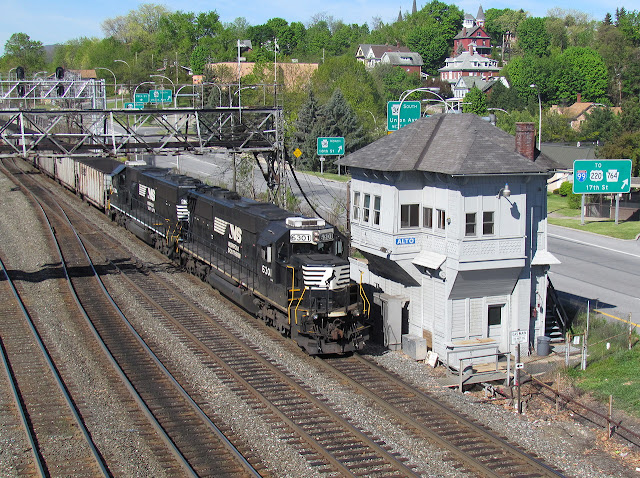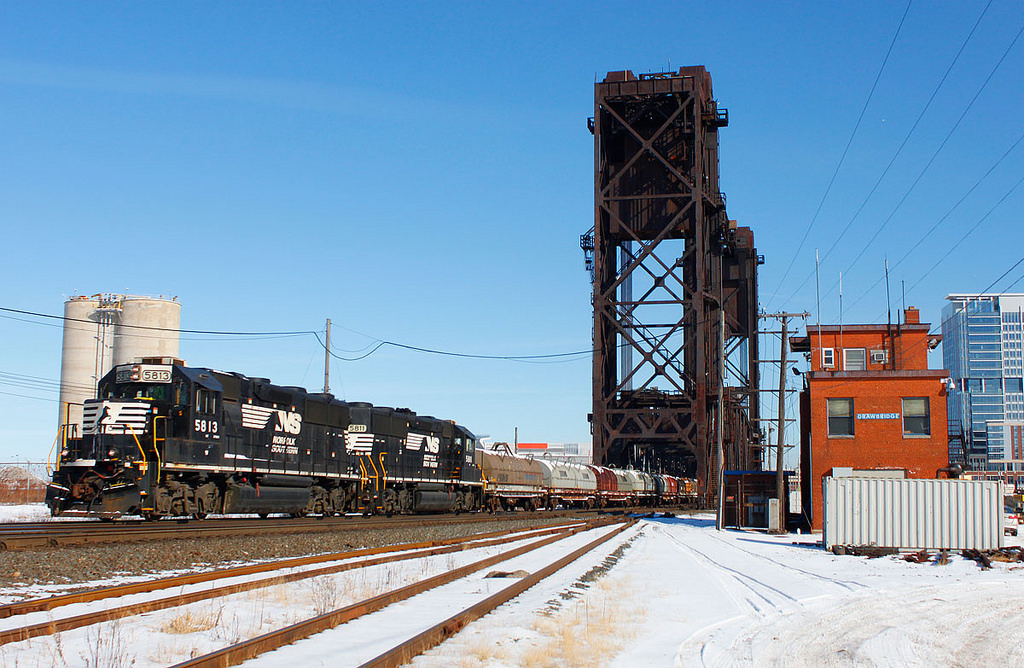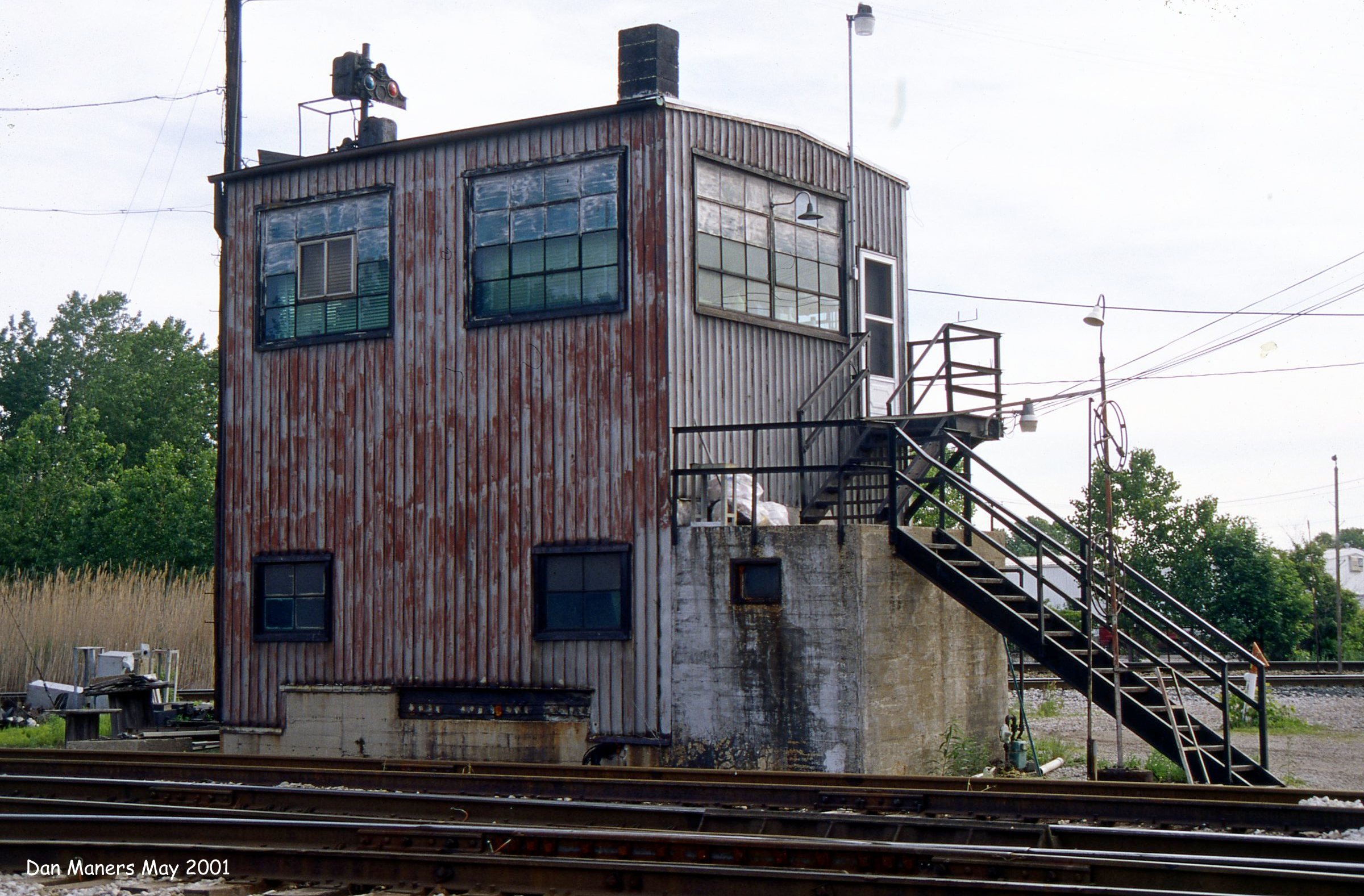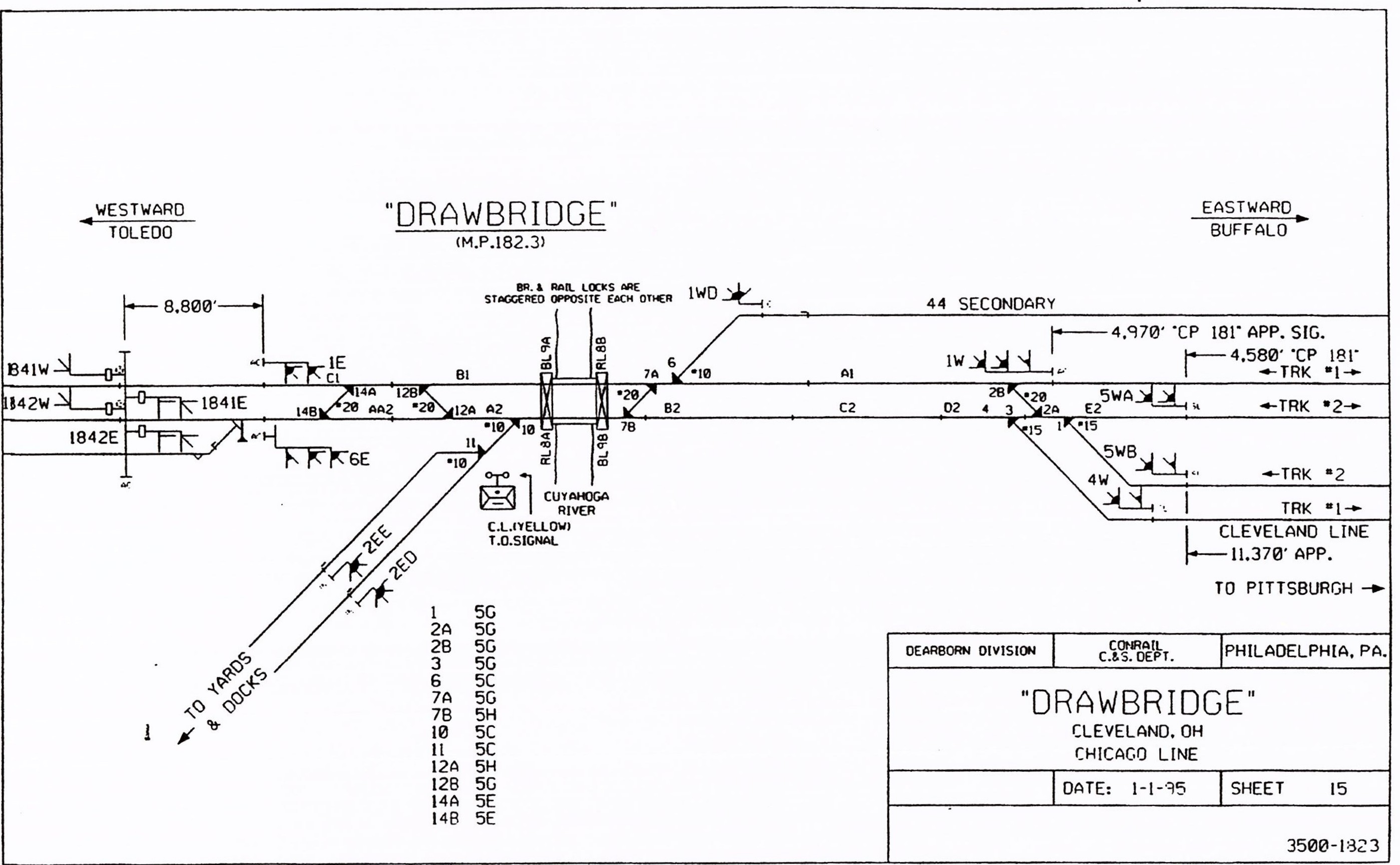In a move that could only make sense as part of some nefarious plan to cripple Amtrak service, Canadian National has single tracked a critical portion of its connecting line between the former Illinois Central main line and it's Chicago area distributor that runs west to Joliet on the former Chicago and Alton alignment. Specifically the mile or so long segment between the two major passenger crossings at 16th St and 21st St, the former controlled by a famous METRA interlocking tower and the second by Amtrak's Chicago terminal train directors.
As you can see in the above diagram CN has cut Main Track 1 between a new 18TH ST interlocking and the existing CERMACK interlocking. The method of the cut will create bottlenecks for Illini Service Amtrak trains on and off the St Charles Air Line from downstate and Lincoln Service trains entering and exiting the Heritage Corridor at CERMACK due to Conrail style interlockings that eliminate any sort of parallel operation. Why would they do such a thing?
The answer is diamonds, and not the kind that makes one wealthy. Elimination of Main Track #1 will also eliminate 5 diamonds between both interlockings. For those of you who don't know, main line diamonds are expensive maintenance items that also require fairly periodic replacement.
As we can see from this photo at 21st St, the small signs seem to indicate that the diamonds are the maintenance responsibility of CN. The bottleneck will be felt as freight white periods at both crossings cause CN traffic to back up along the line and this will now preclude Amtrak service from being able to sneak by. Perhaps that is the ultimate point. "Unavoidable" delays may force the State's hand in funding alternatives to the diamond crossings like an overpass at 16th St and the Grand Crossing connector on the NS Chicago Line south of the city. The real loser is the 16th St tower which will loose a substantial number of its remaining active levers :-(
A blog devoted to explaining the ins and outs of North American railroad signaling, past, present and future. This blog seeks to preserve through photo documentation the great diversity and technical ingenuity of 20th century signaling and interlocking hardware and technology. Related topics cover interlocking towers and railroad communications infrastructure.
Note, due to a web hosting failure some of the photos and links may be unavailable.
Search This Blog
Wednesday, July 31, 2019
Sunday, July 21, 2019
ALTO: One Tower, Four Roads
This article originally appeared in The Trackside Photographer in November of 2018. It builds on my previous coverage of ALTO tower posted in 2011 with additional photos taken in 2012 and 2018 and additional reference materials that I had obtained during the intervening years.
ALTO (JK) tower, in Altoona, Pennsylvania, was built by the Pennsylvania Railroad in 1915 and remained in service for the next 97 years, closing in 2012. Over that time it worked under the auspices of four different railroads, the PRR, Penn Central, Conrail and Norfolk Southern and each railroad, in turn, brought something new to the table. It is easy to think of railroad history over the last century to be one of subtraction, infrastructure being removed as a transportation monopoly yielded to competition from air travel and highways. However, for at least it's 97 years in service, ALTO's story was one of adaptation to the ever changing times.
What did the PRR bring to ALTO? A simple answer is wealth. The PRR was something like the Google or Amazon of it's day, a technological pioneer with the deep pockets to afford more than the basics. The wooden construction wasn't a cost cutting measure, but actually a mark of the PRR's dynamism as up into the early years of the 20th century the railroad's constant re-investment would render interlocking towers quickly obsolete, requiring frequent replacement. In fact the odd pop-out on the east side of the tower was added when the original interlocking machine proved to be insufficient and a two more had to be installed in the 1930's. On the front of the tower, the bay window was an optional extra that gave the tower staff an unobstructed view of the Main Line, reducing delays and operator error.
Although ALTO's design had a degree of implied disposability, the PRR nevertheless spent money on architectural flourishes such as the fish-scale siding, the shade over the relay room windows and the wheel-like ornamentation.
To control the train movements at the west end of the busy Altoona passenger station and the freight yard, the PRR invested in an early style of Union Switch and Signal Electro-Pneumatic interlocking machine with 27 levers. In 1915 this type of machine was typically seen only in major urban junctions and station terminals like New York's Penn Station, but the PRR had no compunction against installing a very expensive piece of technology in what might otherwise be a "temporary" interlocking tower given the railroad's uniquely heavy traffic density. Still, the PRR was no spendthrift and had a penchant for building slow speed interlocking plants in busy terminal areas. Since trains were going to be making station stops, changing power or having helpers attached little was lost in having all trains move through the interlocking at 15 mph with the advantage of vastly simplified interlocking logic and compact dwarf signals.
Although by 1915 most interlocking arrangements in North America made use of track circuits and other forms of non-mechanical logic, "armstrong" style lever frames with mechanically worked switches were still the norm as they reduced the number of the highly expensive relays and could also be run on battery power. Situated in the PRR's own company town, the road had no problems supplying ALTO with a full time source of electricity.
ALTO (JK) tower, in Altoona, Pennsylvania, was built by the Pennsylvania Railroad in 1915 and remained in service for the next 97 years, closing in 2012. Over that time it worked under the auspices of four different railroads, the PRR, Penn Central, Conrail and Norfolk Southern and each railroad, in turn, brought something new to the table. It is easy to think of railroad history over the last century to be one of subtraction, infrastructure being removed as a transportation monopoly yielded to competition from air travel and highways. However, for at least it's 97 years in service, ALTO's story was one of adaptation to the ever changing times.
 |
| ALTO tower in 2012 as a pair of NS helpers push past. |
What did the PRR bring to ALTO? A simple answer is wealth. The PRR was something like the Google or Amazon of it's day, a technological pioneer with the deep pockets to afford more than the basics. The wooden construction wasn't a cost cutting measure, but actually a mark of the PRR's dynamism as up into the early years of the 20th century the railroad's constant re-investment would render interlocking towers quickly obsolete, requiring frequent replacement. In fact the odd pop-out on the east side of the tower was added when the original interlocking machine proved to be insufficient and a two more had to be installed in the 1930's. On the front of the tower, the bay window was an optional extra that gave the tower staff an unobstructed view of the Main Line, reducing delays and operator error.
 |
| Extensible wooden construction. |
Although ALTO's design had a degree of implied disposability, the PRR nevertheless spent money on architectural flourishes such as the fish-scale siding, the shade over the relay room windows and the wheel-like ornamentation.
 |
| Transportation themed ornamentation. |
To control the train movements at the west end of the busy Altoona passenger station and the freight yard, the PRR invested in an early style of Union Switch and Signal Electro-Pneumatic interlocking machine with 27 levers. In 1915 this type of machine was typically seen only in major urban junctions and station terminals like New York's Penn Station, but the PRR had no compunction against installing a very expensive piece of technology in what might otherwise be a "temporary" interlocking tower given the railroad's uniquely heavy traffic density. Still, the PRR was no spendthrift and had a penchant for building slow speed interlocking plants in busy terminal areas. Since trains were going to be making station stops, changing power or having helpers attached little was lost in having all trains move through the interlocking at 15 mph with the advantage of vastly simplified interlocking logic and compact dwarf signals.
 |
| Original 1915 US&S "EP" style interlocking machine. |
Although by 1915 most interlocking arrangements in North America made use of track circuits and other forms of non-mechanical logic, "armstrong" style lever frames with mechanically worked switches were still the norm as they reduced the number of the highly expensive relays and could also be run on battery power. Situated in the PRR's own company town, the road had no problems supplying ALTO with a full time source of electricity.
 |
| Rear of the 27 lever EP machine. The glass top is protected by a canvas mat. |
Sunday, July 14, 2019
CP-ROCHESTER Gutted
This might be a few weeks old, but I just wanted to report that the famous CP-ROCHESTER was pretty much completely removed, replaced by a new CP-BRIGHT and CP-BRIDGEWATER. Located in Rochester, PA and not the home of Eastman Kodak, CP-ROCHESTER was the junction between the Conrail Fort Wayne Line, Cleveland Line and Youngstown Line and comprised a complete 4-track crossover with a 2 to 1 track compression on the other side of the Beaver River Bridge on the Cleveland Line.
CP-ROCHESTER was done in by being situated across multiple curves and also because it contained curved turnouts, a real maintenance headache. It was replaced by CP-BRIGHT, a three 3-to-4 track crossover located on tangent track nearer to the New Brighton Flyover, formerly exclusive to the Youngstown Line. Although CP-BRIGHT and CP-ROCHESTER operated in tandem for a time as the tracks between them could be used to hold trains entering Conway Yard, NS ultimately removed all but one crossover and one turnout from CP-ROCHESTER that were used to provide access to the Cleveland Line.
ROCHESTER tower, a rare General Railway Signal plant on the Pensy, had been demolished by Conrail in the early 90's, but the position light signals, equipped with Rule 562 'C' lamps for the Fort Wayne Line and still configured for PRR era Rule 251 operation, had remained in place until 2019.
CP-ROCHESTER was done in by being situated across multiple curves and also because it contained curved turnouts, a real maintenance headache. It was replaced by CP-BRIGHT, a three 3-to-4 track crossover located on tangent track nearer to the New Brighton Flyover, formerly exclusive to the Youngstown Line. Although CP-BRIGHT and CP-ROCHESTER operated in tandem for a time as the tracks between them could be used to hold trains entering Conway Yard, NS ultimately removed all but one crossover and one turnout from CP-ROCHESTER that were used to provide access to the Cleveland Line.
ROCHESTER tower, a rare General Railway Signal plant on the Pensy, had been demolished by Conrail in the early 90's, but the position light signals, equipped with Rule 562 'C' lamps for the Fort Wayne Line and still configured for PRR era Rule 251 operation, had remained in place until 2019.
Sunday, July 7, 2019
HALLETT Tower Closes (DB DRAWBRIDGE too)
Just got the bad news that what I believe is the last "tower" style tower in Ohio closed some time in late April. HALLETT, located north of Toledo, was owned and operated by the Ann Arbor regional railroad and also served as its dispatch center. It was the last in a plethora of Toledo area towers, including STANLEY, WALBRIDGE and IRONVILLE, that made it onto the 21st century.
Although it appeared as a strange garden shed, it actually housed a US&S Style S electro-mechanical machine, although from what I heard all of the "armstrong" levers had been removed with the entire plant controlled by the suspended miniature levers. Apparently CSX paid to re-interlock its portion of the plant while the Ann Arbor diamond crossing was turned into an automatic interlocking.
Word is that the Ann Arbor dispatchers are still on site, but will likely be moved to some centralized office belonging to it's corporate parent in another state. This also leaves DELRAY tower in Detroit as the last remaining Style S electro-mechanical machine in North America.

In other Ohio news I just learned, but was not surprised, that NS DRAWBRIDGE tower in Cleveland, Ohio had also been downgraded from a tower to a bridge cabin with a bridge tender. Located at the Junction of the Cleveland and Chicago Lines at the mouth of the Cayuga River, the tower had been re-signaled by Conrail and modified by NS, but still retained some PRR PL dwarf signals on the far side. Like HICK tower in Indiana, the plant was re-signaled again along with NS's general Chicago Line re-signaling project and NS took the opportunity to place switches and signals under dispatcher control.
All of this came to light as NS recently took away what little authority the on site bridge-tender had to open and close the span upon their own authority resulting in massive delays to local marine traffic as the clearance is only a few feet. While one may struggle to think of any towers in Ohio that ARE still open, I am pretty sure a number of bridges still include on site control of switches and signals, including RU tower in Lorain.
Although it appeared as a strange garden shed, it actually housed a US&S Style S electro-mechanical machine, although from what I heard all of the "armstrong" levers had been removed with the entire plant controlled by the suspended miniature levers. Apparently CSX paid to re-interlock its portion of the plant while the Ann Arbor diamond crossing was turned into an automatic interlocking.
Word is that the Ann Arbor dispatchers are still on site, but will likely be moved to some centralized office belonging to it's corporate parent in another state. This also leaves DELRAY tower in Detroit as the last remaining Style S electro-mechanical machine in North America.

In other Ohio news I just learned, but was not surprised, that NS DRAWBRIDGE tower in Cleveland, Ohio had also been downgraded from a tower to a bridge cabin with a bridge tender. Located at the Junction of the Cleveland and Chicago Lines at the mouth of the Cayuga River, the tower had been re-signaled by Conrail and modified by NS, but still retained some PRR PL dwarf signals on the far side. Like HICK tower in Indiana, the plant was re-signaled again along with NS's general Chicago Line re-signaling project and NS took the opportunity to place switches and signals under dispatcher control.
Subscribe to:
Posts (Atom)








